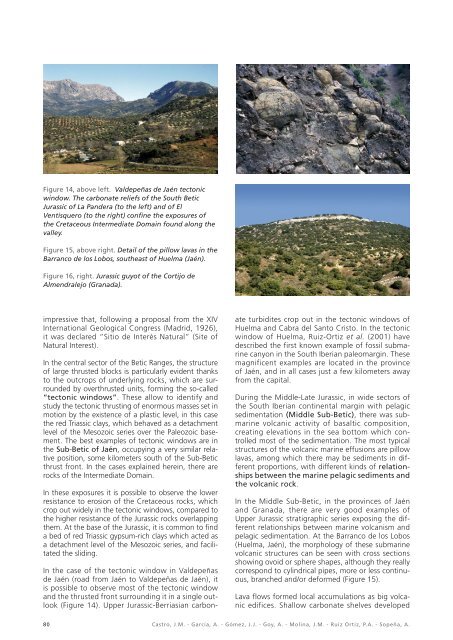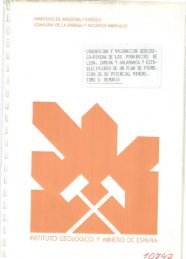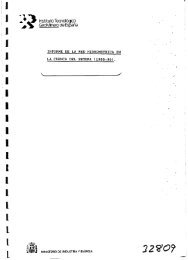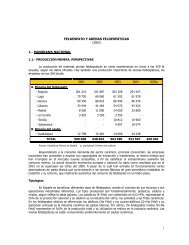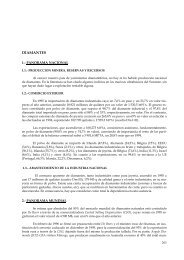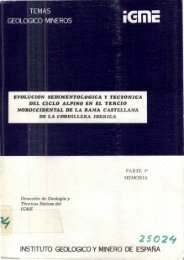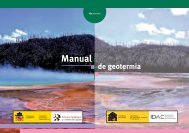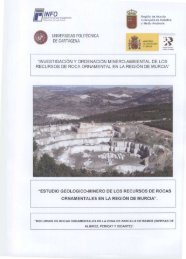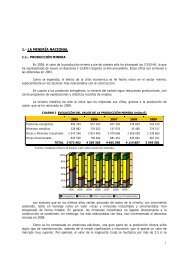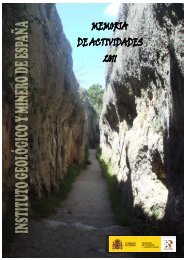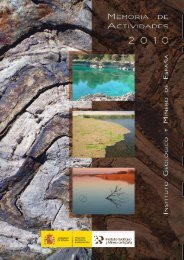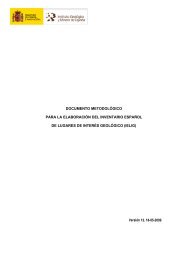mesozoic successions of the betic and iberian ranges - Instituto ...
mesozoic successions of the betic and iberian ranges - Instituto ...
mesozoic successions of the betic and iberian ranges - Instituto ...
You also want an ePaper? Increase the reach of your titles
YUMPU automatically turns print PDFs into web optimized ePapers that Google loves.
Figure 14, above left. Valdepeñas de Jaén tectonic<br />
window. The carbonate reliefs <strong>of</strong> <strong>the</strong> South Betic<br />
Jurassic <strong>of</strong> La P<strong>and</strong>era (to <strong>the</strong> left) <strong>and</strong> <strong>of</strong> El<br />
Ventisquero (to <strong>the</strong> right) confine <strong>the</strong> exposures <strong>of</strong><br />
<strong>the</strong> Cretaceous Intermediate Domain found along <strong>the</strong><br />
valley.<br />
Figure 15, above right. Detail <strong>of</strong> <strong>the</strong> pillow lavas in <strong>the</strong><br />
Barranco de los Lobos, sou<strong>the</strong>ast <strong>of</strong> Huelma (Jaén).<br />
Figure 16, right. Jurassic guyot <strong>of</strong> <strong>the</strong> Cortijo de<br />
Almendralejo (Granada).<br />
impressive that, following a proposal from <strong>the</strong> XIV<br />
International Geological Congress (Madrid, 1926),<br />
it was declared “Sitio de Interés Natural” (Site <strong>of</strong><br />
Natural Interest).<br />
In <strong>the</strong> central sector <strong>of</strong> <strong>the</strong> Betic Ranges, <strong>the</strong> structure<br />
<strong>of</strong> large thrusted blocks is particularly evident thanks<br />
to <strong>the</strong> outcrops <strong>of</strong> underlying rocks, which are surrounded<br />
by overthrusted units, forming <strong>the</strong> so-called<br />
“tectonic windows”. These allow to identify <strong>and</strong><br />
study <strong>the</strong> tectonic thrusting <strong>of</strong> enormous masses set in<br />
motion by <strong>the</strong> existence <strong>of</strong> a plastic level, in this case<br />
<strong>the</strong> red Triassic clays, which behaved as a detachment<br />
level <strong>of</strong> <strong>the</strong> Mesozoic series over <strong>the</strong> Paleozoic basement.<br />
The best examples <strong>of</strong> tectonic windows are in<br />
<strong>the</strong> Sub-Betic <strong>of</strong> Jaén, occupying a very similar relative<br />
position, some kilometers south <strong>of</strong> <strong>the</strong> Sub-Betic<br />
thrust front. In <strong>the</strong> cases explained herein, <strong>the</strong>re are<br />
rocks <strong>of</strong> <strong>the</strong> Intermediate Domain.<br />
In <strong>the</strong>se exposures it is possible to observe <strong>the</strong> lower<br />
resistance to erosion <strong>of</strong> <strong>the</strong> Cretaceous rocks, which<br />
crop out widely in <strong>the</strong> tectonic windows, compared to<br />
<strong>the</strong> higher resistance <strong>of</strong> <strong>the</strong> Jurassic rocks overlapping<br />
<strong>the</strong>m. At <strong>the</strong> base <strong>of</strong> <strong>the</strong> Jurassic, it is common to find<br />
a bed <strong>of</strong> red Triassic gypsum-rich clays which acted as<br />
a detachment level <strong>of</strong> <strong>the</strong> Mesozoic series, <strong>and</strong> facilitated<br />
<strong>the</strong> sliding.<br />
In <strong>the</strong> case <strong>of</strong> <strong>the</strong> tectonic window in Valdepeñas<br />
de Jaén (road from Jaén to Valdepeñas de Jaén), it<br />
is possible to observe most <strong>of</strong> <strong>the</strong> tectonic window<br />
<strong>and</strong> <strong>the</strong> thrusted front surrounding it in a single outlook<br />
(Figure 14). Upper Jurassic-Berriasian carbonate<br />
turbidites crop out in <strong>the</strong> tectonic windows <strong>of</strong><br />
Huelma <strong>and</strong> Cabra del Santo Cristo. In <strong>the</strong> tectonic<br />
window <strong>of</strong> Huelma, Ruiz-Ortiz et al. (2001) have<br />
described <strong>the</strong> first known example <strong>of</strong> fossil submarine<br />
canyon in <strong>the</strong> South Iberian paleomargin. These<br />
magnificent examples are located in <strong>the</strong> province<br />
<strong>of</strong> Jaén, <strong>and</strong> in all cases just a few kilometers away<br />
from <strong>the</strong> capital.<br />
During <strong>the</strong> Middle-Late Jurassic, in wide sectors <strong>of</strong><br />
<strong>the</strong> South Iberian continental margin with pelagic<br />
sedimentation (Middle Sub-Betic), <strong>the</strong>re was submarine<br />
volcanic activity <strong>of</strong> basaltic composition,<br />
creating elevations in <strong>the</strong> sea bottom which controlled<br />
most <strong>of</strong> <strong>the</strong> sedimentation. The most typical<br />
structures <strong>of</strong> <strong>the</strong> volcanic marine effusions are pillow<br />
lavas, among which <strong>the</strong>re may be sediments in different<br />
proportions, with different kinds <strong>of</strong> relationships<br />
between <strong>the</strong> marine pelagic sediments <strong>and</strong><br />
<strong>the</strong> volcanic rock.<br />
In <strong>the</strong> Middle Sub-Betic, in <strong>the</strong> provinces <strong>of</strong> Jaén<br />
<strong>and</strong> Granada, <strong>the</strong>re are very good examples <strong>of</strong><br />
Upper Jurassic stratigraphic series exposing <strong>the</strong> different<br />
relationships between marine volcanism <strong>and</strong><br />
pelagic sedimentation. At <strong>the</strong> Barranco de los Lobos<br />
(Huelma, Jaén), <strong>the</strong> morphology <strong>of</strong> <strong>the</strong>se submarine<br />
volcanic structures can be seen with cross sections<br />
showing ovoid or sphere shapes, although <strong>the</strong>y really<br />
correspond to cylindrical pipes, more or less continuous,<br />
branched <strong>and</strong>/or deformed (Figure 15).<br />
Lava flows formed local accumulations as big volcanic<br />
edifices. Shallow carbonate shelves developed<br />
80<br />
Castro, J.M. - García, A. - Gómez, J.J. - Goy, A. - Molina, J.M. - Ruíz Ortíz, P.A. - Sopeña, A.


